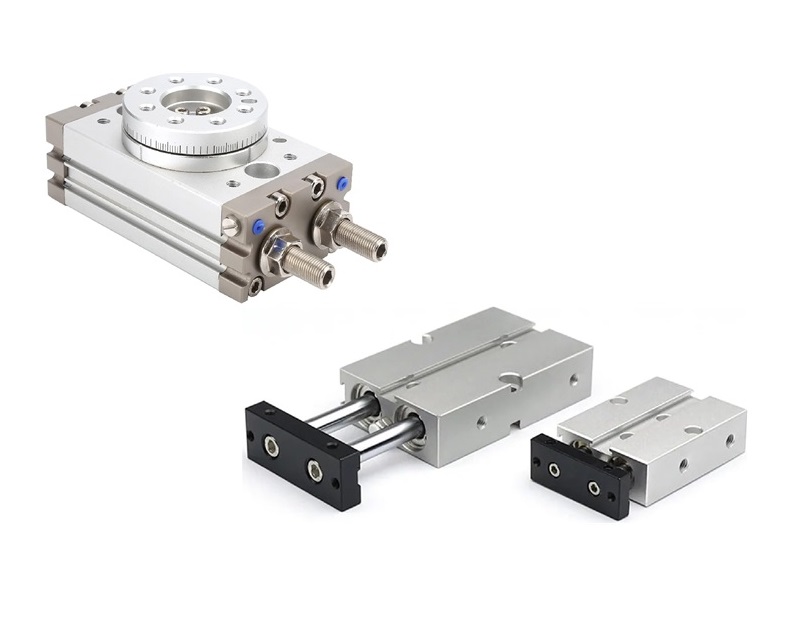When it comes to pneumatic systems, one of the first decisions you’ll face is whether to choose a linear actuator or a rotary actuator. These actuators are crucial components in pneumatic systems, as they convert compressed air into mechanical motion. Each type of actuator offers unique motion capabilities, and selecting the right one is essential for your specific pneumatic application needs. In this guide, we’ll compare linear and rotary actuators in pneumatic systems, discussing their functions, applications, benefits, and limitations.
Understanding Pneumatic Actuators: Linear vs. Rotary
Actuators are essential in converting compressed air into mechanical motion for industrial equipment powered by pneumatics, enabling a wide range of tasks in various applications. They can provide either straight-line (linear) or rotational (rotary) motion, allowing them to handle a variety of industrial tasks.
What is a Linear Actuator?
A linear actuator in a pneumatic system converts compressed air into linear (straight-line) motion. Pneumatic cylinders are often used as linear actuators, providing precise pushing, pulling, or lifting actions. This type of actuator is ideal for tasks requiring linear motion, such as moving items along conveyors, lifting objects, or pressing materials. Linear actuators are essential in applications where compressed air must be harnessed to create controlled, straight-line movements.
Advantages of Linear Actuators
- Precision: Ideal for applications that require highly controlled linear motion.
- Ease of Use: Simple operation makes them effective for tasks involving straightforward, repetitive motions.
- Versatility: Pneumatic linear actuators, like pneumatic cylinders, can handle a wide range of tasks requiring linear movement, from lifting and pushing to aligning products.
Limitations of Linear Actuators
- Limited to Straight-Line Movement: Linear actuators are not suitable for tasks that require rotation or pivoting.
- Space Constraints: The length of the actuator must accommodate the full range of motion, which can be a limiting factor in compact setups. In such cases, cylinders for tight spaces may be a better option, as they offer a more compact design while still providing the necessary motion.
What is a Rotary Actuator?
A rotary actuator, on the other hand, offers pivoting or rotating motion that is usually expressed in degrees. Applications needing controlled turning, including positioning adjustments or valve opening and shutting, frequently employ rotary actuators.
Advantages of Rotary Actuators
- Compact Design: Rotary actuators often have a smaller footprint, making them ideal for spaces with limited room.
- Continuous or Partial Rotation: Suitable for applications requiring specific rotational angles, from small pivots to continuous 360-degree rotation.
- Versatile Positioning: Provides greater flexibility for tasks involving turning, pivoting, or spinning motions.
Limitations of Rotary Actuators
- Lack of Linear Motion: They’re limited to rotational tasks and are not suitable for applications that require straight-line movement.
- Precision Control: While rotary actuators can offer controlled movement, some models may lack the precision of linear actuators in certain tasks.
Linear vs. Rotary Actuators Key Comparison Points: Choosing the Right Fit
Let’s evaluate pneumatic linear actuators and rotary actuators based on several factors, including their function, application suitability, and design specifications, to help you make an informed decision for your pneumatic system.
| Factors | Linear Actuators | Rotary Actuators |
| Motion Requirement | Ideal for tasks requiring straight-line movement, such as pushing, pulling, or lifting. | Best for tasks requiring turning, pivoting, or rotating actions. |
| Space Constraints | Requires more physical space to accommodate full extension. | More compact, ideal for tight spaces where rotation is needed. |
| Precision Needs | Offers higher precision for straight-line tasks, like positioning or alignment. | Precision can vary, but is generally effective for rotational applications. |
| Speed and Force | Can offer greater force in straight-line tasks, especially when using pneumatic cylinders. | Operates at high speeds but may generate less force than linear actuators. |
| Application | Common in applications like material handling, conveyor belts, or robotic arms. | Used in applications like valve control, swivelling mechanisms, and part positioning. |
Practical Applications: Rotary vs. Linear Actuator
Determining which type of actuator best suits your needs can be aided by knowing the differences between rotary and linear actuator applications.
- Linear Actuators are widely used in:
- Robotic assembly lines are used to move items in straight paths.
- Packaging processes that require pressing, lifting, or aligning products.
- Automotive manufacturing, particularly in processes involving lifting and pressing.
- Rotary Actuators are typically found in:
- Valve controls, especially in industries like oil and gas or water treatment.
- Robotic arms that require rotational movement for positioning.
- Conveyor systems need pivoting or spinning motion for sorting tasks.
Key Considerations for Choosing the Right Pneumatic Actuator
When selecting a pneumatic actuator, it’s important to balance the task requirements, available space, and budget to suit your system’s needs. Linear actuators, especially pneumatic cylinders, are often simple to maintain and perform cylinder repair relatively easily due to their straightforward design, making them ideal for direct push or pull tasks. Rotary actuators, on the other hand, are compact and well-suited for pivoting or rotational actions, but they may require more complex maintenance. Assess these factors in relation to your application’s goals to choose the most efficient fit.

